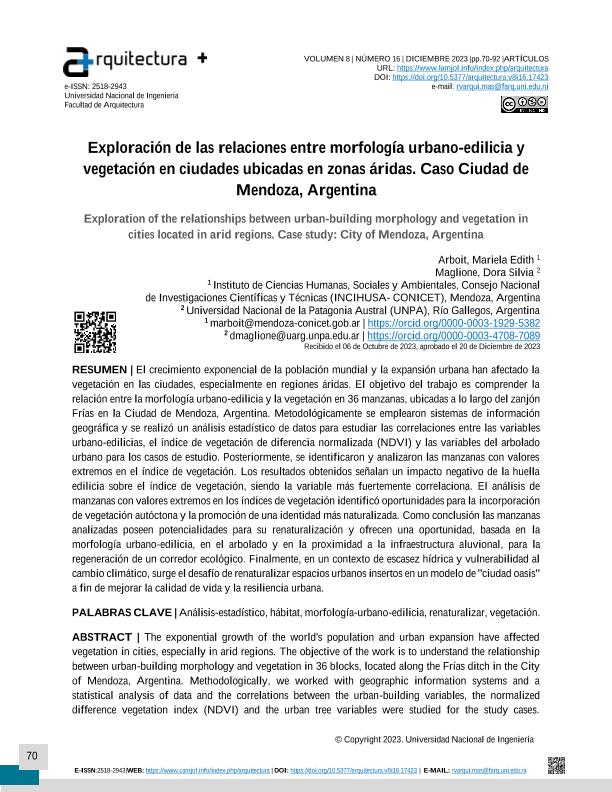Artículo
El crecimiento exponencial de la población mundial y la expansión urbana han afectado la vegetación en las ciudades, especialmente en regiones áridas. El objetivo del trabajo es comprender la relación entre la morfología urbano-edilicia y la vegetación en 36 manzanas, ubicadas a lo largo del zanjón Frías en la Ciudad de Mendoza, Argentina.Metodológicamente se emplearon sistemas de información geográfica y se realizó un análisis estadístico de datos para estudiar las correlaciones entre las variables urbano-edilicias, el índice de vegetación de diferencia normalizada (NDVI) y las variables del arbolado urbano para los casos de estudio. Posteriormente, se identificaron y analizaron las manzanas con valores extremos en el índice de vegetación.Los resultados obtenidos señalan un impacto negativo de la huella edilicia sobre el índice de vegetación, siendo la variable más fuertemente correlaciona. El análisis de manzanas con valores extremos en los índices de vegetación identificó oportunidades para la incorporación de vegetación autóctona y la promoción de una identidad más naturalizada. Como conclusión las manzanas analizadas poseen potencialidades para su renaturalización y ofrecen una oportunidad, basada en la morfología urbano-edilicia, en el arbolado y en la proximidad a la infraestructura aluvional, para la regeneración de un corredor ecológico. Finalmente, en un contexto de escasez hídrica y vulnerabilidad al cambio climático, surge el desafío de renaturalizar espacios urbanos insertos en un modelo de "ciudad oasis" a fin de mejorar la calidad de vida y la resiliencia urbana. The exponential growth of the world's population and urban expansion have affected vegetation in cities, especially in arid regions. The objective of the work is to understand the relationship between urban-building morphology and vegetation in 36 blocks, located along the Frías ditch in the City of Mendoza, Argentina. Methodologically, we worked with geographic information systems and a statistical analysis of data and the correlations between the urban-building variables, the normalized difference vegetation index (NDVI) and the urban tree variables were studied for the study cases. Subsequently, blocks with extreme values in the vegetation index were identified and analyzed. The results obtained indicate a negative impact of the building footprint on the vegetation index, with the variable being the most strongly correlated. The analysis of blocks with extreme values in the vegetation indices identified opportunities for the incorporation of native vegetation and the promotion of a more naturalized identity. In conclusion, the blocks analyzed have potential for renaturalization and offer an opportunity, based on the urban-building morphology, the trees and the proximity to the alluvial infrastructure, for the regeneration of an ecological corridor. Finally, in a context of water scarcity and vulnerability to climate change, the challenge arises of renaturalizing urban spaces inserted in an "oasis city" model in order to improve quality of life and urban resilience.
Exploración de las relaciones entre morfología urbano-edilicia y vegetación en ciudades ubicadas en zonas áridas: Caso Ciudad de Mendoza, Argentina
Título:
Exploration of the relationships between urban-building morphology and vegetation in cities located in arid regions: Case study. City of Mendoza, Argentina
Fecha de publicación:
12/2023
Editorial:
Universidad Nacional de Ingeniería. Facultad de Arquitectura
Revista:
Revista Arquitectura +
e-ISSN:
2518-2943
Idioma:
Español
Tipo de recurso:
Artículo publicado
Clasificación temática:
Resumen
Archivos asociados
Licencia
Identificadores
Colecciones
Articulos(INCIHUSA)
Articulos de INST. DE CS. HUMANAS, SOC. Y AMBIENTALES
Articulos de INST. DE CS. HUMANAS, SOC. Y AMBIENTALES
Citación
Arboit, Mariela Edith; Maglione, Dora Silvia; Exploración de las relaciones entre morfología urbano-edilicia y vegetación en ciudades ubicadas en zonas áridas: Caso Ciudad de Mendoza, Argentina; Universidad Nacional de Ingeniería. Facultad de Arquitectura; Revista Arquitectura +; 8; 16; 12-2023; 70-92
Compartir




